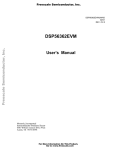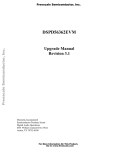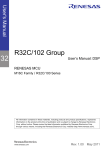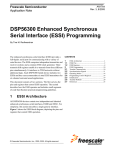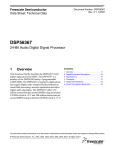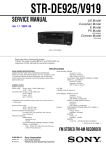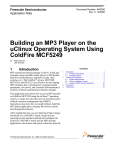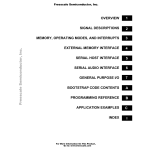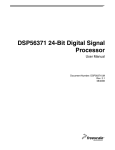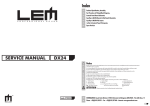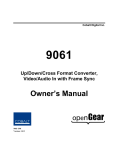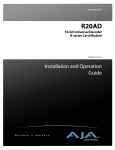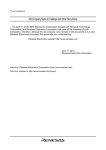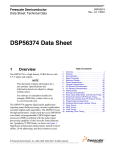Download enhanced serial audio interface (esai)
Transcript
Freescale Semiconductor, Inc. Freescale Semiconductor Freescale Semiconductor, Inc... Revision 1.0 Published 05/00 AN1848/D (Motorola Order Number) ENHANCED SERIAL AUDIO INTERFACE (ESAI) Programming and Interfacing Techniques Application Note By: Brent Karley © Freescale Semiconductor, Inc., 2004. All rights reserved. For More Information On This Product, Go to: www.freescale.com Freescale Semiconductor, Inc. How to Reach Us: Home Page: www.freescale.com Freescale Semiconductor, Inc... E-mail: [email protected] USA/Europe or Locations Not Listed: Freescale Semiconductor Technical Information Center, CH370 1300 N. Alma School Road Chandler, Arizona 85224 +1-800-521-6274 or +1-480-768-2130 [email protected] Europe, Middle East, and Africa: Freescale Halbleiter Deutschland GmbH Technical Information Center Schatzbogen 7 81829 Muenchen, Germany +44 1296 380 456 (English) +46 8 52200080 (English) +49 89 92103 559 (German) +33 1 69 35 48 48 (French) [email protected] Japan: Freescale Semiconductor Japan Ltd. Headquarters ARCO Tower 15F 1-8-1, Shimo-Meguro, Meguro-ku, Tokyo 153-0064 Japan 0120 191014 or +81 3 5437 9125 [email protected] Asia/Pacific: Freescale Semiconductor Hong Kong Ltd. Technical Information Center 2 Dai King Street Tai Po Industrial Estate Tai Po, N.T., Hong Kong +800 2666 8080 [email protected] For Literature Requests Only: Freescale Semiconductor Literature Distribution Center P.O. Box 5405 Denver, Colorado 80217 1-800-441-2447 or 303-675-2140 Fax: 303-675-2150 [email protected] Information in this document is provided solely to enable system and software implementers to use Freescale Semiconductor products. There are no express or implied copyright licenses granted hereunder to design or fabricate any integrated circuits or integrated circuits based on the information in this document. Freescale Semiconductor reserves the right to make changes without further notice to any products herein. Freescale Semiconductor makes no warranty, representation or guarantee regarding the suitability of its products for any particular purpose, nor does Freescale Semiconductor assume any liability arising out of the application or use of any product or circuit, and specifically disclaims any and all liability, including without limitation consequential or incidental damages. “Typical” parameters which may be provided in Freescale Semiconductor data sheets and/or specifications can and do vary in different applications and actual performance may vary over time. All operating parameters, including “Typicals” must be validated for each customer application by customer’s technical experts. Freescale Semiconductor does not convey any license under its patent rights nor the rights of others. Freescale Semiconductor products are not designed, intended, or authorized for use as components in systems intended for surgical implant into the body, or other applications intended to support or sustain life, or for any other application in which the failure of the Freescale Semiconductor product could create a situation where personal injury or death may occur. Should Buyer purchase or use Freescale Semiconductor products for any such unintended or unauthorized application, Buyer shall indemnify and hold Freescale Semiconductor and its officers, employees, subsidiaries, affiliates, and distributors harmless against all claims, costs, damages, and expenses, and reasonable attorney fees arising out of, directly or indirectly, any claim of personal injury or death associated with such unintended or unauthorized use, even if such claim alleges that Freescale Semiconductor was negligent regarding the design or manufacture of the part. For More Information On This Product, Go to: www.freescale.com Freescale Semiconductor, Inc. Introduction to the ESAI ESAI Overview SECTION 1 Freescale Semiconductor, Inc... INTRODUCTION TO THE ESAI Interfacing external components to Motorola Digital Signal Processors (DSPs) using the Enhanced Serial Audio Interface (ESAI) peripheral involves both hardware and software coordination. Implementing proper methods and techniques provides considerable system enhancements over conventional serial peripherals. Applications such as DVD, HDTV, set-top box, as well as portable audio and A/V applications such as home theater, can utilize the ESAI to enhance system functionality, reduce system cost, and simultaneously simplify design implementations. This application note provides a tutorial on utilizing the ESAI peripheral including several hardware and software examples. This application note is recommended for developers with solid programming knowledge and a basic understanding of IC interfacing. • This section provides an overview of the ESAI peripheral pins and application considerations. • Section 2, describes hardware interfacing to external components. • Section 3, contains several hardware interfacing examples using the ESAI with some of the most common peripheral components. • Section 4, describes common audio data transfer protocols. • Section 5, provides an overview of how to program the ESAI control registers with examples for I2S, Left Justified, and EIAJ protocols. • Section 6, provides an ESAI programming example. 1.1 ESAI OVERVIEW The Enhanced Serial Audio Interface (ESAI) is an integration of the multi-capable Enhanced Synchronous Serial Interface (ESSI) common to many of Motorola’s DSP56300 processors and the Serial Audio Interface (SAI) designed specifically for consumer and professional audio applications on Motorola’s first generation of dedicated audio processors known as the SymphonyTM family. ESAI Programming and Interfacing Techniques For More Information On This Product, Go to: www.freescale.com 1-1 Freescale Semiconductor, Inc. Introduction to the ESAI ESAI Structure Freescale Semiconductor, Inc... The ESAI provides for simple interfacing to common audio Analog-to-Digital converters (ADC) and Digital-to-Analog converters (DACs) which utilize the I2S interfacing protocol. The ESAI provides several advanced audio peripheral capabilities such as: • Flexibility in the number of inputs and outputs supported • Over sample clocking support • Hardware driven multiplexing • Right justified (EIAJ) support • AC-97 capabilities This application note describes how to utilize these features (except for AC-97 which is covered in application note APR37) with examples of both hardware interfacing and software programming. 1.2 ESAI STRUCTURE The ESAI is divided into separate receiver and transmitter sections with independent bit clocks, framesync clocks, and over sample clocks. The ESAI can be programmed to operate the transmitter and receiver sections in the following ways: Table 1-1 Transmitter and Receiver Section Programming Mode Description synchronous Receiver and transmitter using the same clock source asynchronous Receiver and transmitter using different clock sources master slave Clocks generated by the DSP core Clocks provided externally The number of I/O pins may vary depending upon the particular DSP utilized. Typically, six data I/O pins are available, two of which are dedicated outputs and four of which are programmable as either input or output. Figure 1-1 shows each of the pins associated with the ESAI peripheral as implemented on the DSP56362. A description of each pin is provided in Table 1-2, “Audio Data I/O Pin Function,” on page 1-3. ESAI Programming and Interfacing Techniques For More Information On This Product, Go to: www.freescale.com 1-2 Freescale Semiconductor, Inc. Introduction to the ESAI ESAI Structure Motorola DSP56362 Three dedicated Receiver Pins Freescale Semiconductor, Inc... Four Enhanced Programmable I/O Serial Pins Audio Interface Five (ESAI) Dedicated Transmitter Pins SCKR FSR HCKR SDO5/SDI0 SDO4/SDI1 SDO3/SDI2 SDO2/SDI3 SCKT FST HCKT SDO1 SDO0 Figure 1-1 ESAI Pins 1.2.1 ESAI PIN DESCRIPTION The following table describes how each pin transfers audio data in and out of the DSP. Table 1-2 Audio Data I/O Pin Function Pin Name SCKR Pin Description The receive bit clock is utilized to clock in each bit of audio data received by the DSP. The receive bit clock signal can either be generated by the DSP (master mode) or generated externally (slave mode). FSR The receive framesync clock is utilized to clock in each audio sample received by the DSP. The receive framesync clock signal can either be generated by the DSP (master mode) or generated externally (slave mode). HCKR The receive over sample clock is not necessary for operation by the DSP but is convenient for generating the bit clock (SCKR) and framesync clock (FSR). The receive over sample clock signal can either be generated by the DSP (master mode) or generated externally (slave mode). SCKT The transmit bit clock is utilized to clock out each bit of audio data transmitted by the DSP. The transmit bit clock signal can either be generated by the DSP (master mode) or generated externally (slave mode). FST The transmit framesync clock is utilized to clock out each audio sample transmitted by the DSP. The transmit framesync clock signal can either be generated by the DSP (master mode) or generated externally (slave mode). HCKT The transmit over sample clock is not necessary for operation by the DSP but is convenient for generating the bit clock (SCKT) and framesync clock (FST). The transmit over sample clock signal can either be generated by the DSP (master mode) or generated externally (slave mode). SDO5/SDI0 The SDO5/SDI0 data pin can be programmed as either a transmitter (SDO5) or as a receiver (SDI0). When operating as a transmitter this pin operates in conjunction with the transmit clocks (SCKT, FST, HCKT) to transmit data out of the DSP. When operating as a receiver this pin operates in conjunction with the receiver clocks (SCKR, FSR, HCKR) to receive data into the DSP. ESAI Programming and Interfacing Techniques For More Information On This Product, Go to: www.freescale.com 1-3 Freescale Semiconductor, Inc. Introduction to the ESAI ESAI Structure Table 1-2 Audio Data I/O Pin Function Freescale Semiconductor, Inc... Pin Name Pin Description SDO4/SDI1 The SDO4/SDI1 data pin can be programmed as either a transmitter (SDO4) or as a receiver (SDI1). When operating as a transmitter this pin operates in conjunction with the transmit clocks (SCKT, FST, HCKT) to transmit data out of the DSP. When operating as a receiver this pin operates in conjunction with the receiver clocks (SCKR, FSR, HCKR) to receive data into the DSP. SDO3/SDI2 The SDO3/SDI2 data pin can be programmed as either a transmitter (SDO3) or as a receiver (SDI2). When operating as a transmitter this pin operates in conjunction with the transmit clocks (SCKT, FST, HCKT) to transmit data out of the DSP. When operating as a receiver this pin operates in conjunction with the receiver clocks (SCKR, FSR, HCKR) to receive data into the DSP. SDO2/SDI3 The SDO2/SDI3 data pin can be programmed as either a transmitter (SDO2) or as a receiver (SDI3). When operating as a transmitter this pin operates in conjunction with the transmit clocks (SCKT, FST, HCKT) to transmit data out of the DSP. When operating as a receiver this pin operates in conjunction with the receiver clocks (SCKR, FSR, HCKR) to receive data into the DSP. 1.2.2 SDO1 The SDO1 data pin operates only as a transmitter pin in conjunction with the transmitter clocks. SDO0 The SDO0 data pin operates only as a transmitter pin in conjunction with the transmitter clocks. ESAI PIN CONFIGURATIONS Table 1-3 shows the possible ESAI input/output combinations given six data I/O pins. Each input and output pin can be programmed to carry from one to thirty-two data slots. Each slot can be used to carry an audio sample. Table 1-3 ESAI Input/Output Configurations Configuration Input Pins Output Pins 1 0 6 2 1 5 3 2 4 4 3 3 5 4 2 Typically, the ESAI is programmed for two slots (left channel, right channel) as shown in Figure 1-2. Section 4, Digital Audio Transfer Protocols, describes common audio transfer protocols which utilize this two slot concept. ESAI Programming and Interfacing Techniques For More Information On This Product, Go to: www.freescale.com 1-4 Freescale Semiconductor, Inc. Introduction to the ESAI Application Considerations Framesync (FSR,FST) Left Sample slot 0 Right Sample slot 1 Bit Clock (SCKR,SCKT) Freescale Semiconductor, Inc... Data (SDIx,SDOx) Figure 1-2 Data Transfer over ESAI 1.3 APPLICATION CONSIDERATIONS The ESAI is efficient for applications that implement multichannel processing. Applications such as cinema processing and home theater typically implement decompression algorithms (i.e. Dolby Digital, DTS, MPEG, Pro Logic, etc...) that can take advantage of the many I/O features in the ESAI. The ESAI’s multiple I/Os and flexible protocol support make it a good fit for these applications. However, because the ESAI is a versatile peripheral, there are several system level questions to consider regarding how to best implement the ESAI such as: • How many input and output channels are required for the system? • What type of hardware interface is required to support the external components? • What data transfer protocols do the external components support? • What are the clocking requirements for the external components? 1.3.1 INPUT AND OUTPUT CHANNELS Figure 1-3 shows a typical multichannel implementation. However, the number of channels that an audio system supports is not necessarily the number of inputs and outputs utilized on the ESAI port of the DSP. Some systems may multiplex their data on fewer inputs or outputs by interleaving channels of data on a single ESAI input or output. One ESAI pin can transmit up to 32 channels of data by using all 32 slots. ESAI Programming and Interfacing Techniques For More Information On This Product, Go to: www.freescale.com 1-5 Freescale Semiconductor, Inc. Introduction to the ESAI Application Considerations Left SDO0 ADC DAC Left Right SDI0 Right SDO1 Motorola DSP563xx ESAI Freescale Semiconductor, Inc... Digital input SPDIF RX SDO2 DAC Center Subwoofer DAC Left Surround Right Surround SDI1 SDO3 SPDIF TX Left Auxiliary Right Auxiliary Figure 1-3 Multichannel Processor I/O Block Diagram 1.3.2 HARDWARE INTERFACE Hardware interface requirements can vary depending upon the specific type of converter and other peripheral components in the system. Most audio components support a three line transmission interface consisting of a: 1. Data line 2. Bit clock 3. Framesync clock Not all audio components support a three line interface. Some components also require a high frequency over sampled clock. Another hardware interface variation is required for mono ADCs and DACs. For example, many high end mono converters such as the Burr Brown PCM63 utilize a data latch rather than a framesync and thus receive only one channel of data. 1.3.3 TRANSFER PROTOCOL The ESAI supports multiple I/O protocols, even those protocols which are not necessarily common to audio components. The type of protocol utilized should be matched with the protocols supported by external components in the audio system. The most common audio protocols are I2S, left justified, and EIAJ (right justified) formats. However, as described in ESAI Programming and Interfacing Techniques For More Information On This Product, Go to: www.freescale.com 1-6 Freescale Semiconductor, Inc. Introduction to the ESAI Application Considerations the previous section, mono converters may utilize a unique hardware interface and transfer protocol. Some components utilize multiplexed data across a single input or output or may demand a high frequency over sampled clock. Freescale Semiconductor, Inc... 1.3.4 CLOCKING REQUIREMENTS Some audio components have the ability to generate system clocks and operate in master mode while others can only operate in slave mode receiving clocks from other system components. The clocking requirements of any system must be considered when determining which components to use. Jitter specifications must also be met to gain maximum quality from system components. These clocking considerations are described in more detail in Hardware Handling and Layout Considerations on page 2 - 5. ESAI Programming and Interfacing Techniques For More Information On This Product, Go to: www.freescale.com 1-7 Freescale Semiconductor, Inc. Introduction to the ESAI Freescale Semiconductor, Inc... Application Considerations 1-8 AI Programming and Interfacing Techniques MOTOROLA For More Information On This Product, Go to: www.freescale.com Freescale Semiconductor, Inc. ESAI Hardware Design Considerations Interfacing the ESAI to External Components SECTION 2 Freescale Semiconductor, Inc... ESAI HARDWARE DESIGN CONSIDERATIONS The ESAI peripheral is designed to easily interface with all conventional audio peripherals as well as various atypical audio components. This section describes the hardware interfacing items as they relate to operating the ESAI with external audio components. 2.1 INTERFACING THE ESAI TO EXTERNAL COMPONENTS Interfacing the ESAI receiver or transmitter to peripheral components requires three pin connections. For each of the receiver and transmitter sections there are the following pin connections: 1. Bit clock (SCKR, SCKT) — Clocks the data bits of every sample in or out 2. Framesync clock (FSR, FST) — Clocks each sample in or out. 3. Various data (SDIx, SDOx) pins — Carries the audio information. Figure 2-1 shows a timing diagram for a typical ESAI audio sample transfer. New Sample Framesync (FSR,FST) New Sample New Sample Right Frame Left Frame Bit Clock (SCKR,SCKT) Data (SDIx,SDOx) 23 0 23 0 Audio Data Figure 2-1 ESAI Timing Diagram ESAI Programming and Interface Techniqes For More Information On This Product, Go to: www.freescale.com 2-1 Freescale Semiconductor, Inc. ESAI Hardware Design Considerations ESAI Clocking Examples 2.2 ESAI CLOCKING EXAMPLES This section describes several common clocking schemes and addresses clocking issues and considerations. Four examples are provided that cover the most common ESAI clocking implementations. Freescale Semiconductor, Inc... 2.2.1 ADC — DSP — DAC INTERFACE Figure 2-2 shows both the ESAI receiver and transmitter operating in slave mode as the clocks are being provided externally from the ADC. The ADC utilizes an external clock oscillator as its over sampled clock source. This design is typical of A/V receivers and portable applications that receive only analog signals utilizing sigma-delta converters. Sigma-delta converters require an over sampled clock. Phase jitter and clock noise are common problems that affect sigma-delta converters which reduces the quality of a converter’s output. Most converters can tolerate some jitter and continue to operate. However, excessive jitter or clock drift reduces signal quality or causes catastrophic failures. This clocking scheme provides a high quality conversion. Providing all clocks from a single over sampled source, such as a low jitter crystal, is one method of reducing jitter in the audio system. Typically, ADCs are provided a master over sampled clock (i.e. 256fs, 384fs or 512fs) and generate the bit clock and framesync clock which is distributed to both the DSP and DAC. ADC DAC MCLKL DSP563xx MCLK RCK FSR FST LRCK BCLK SCKR SCKT BCLK SDO SDI0 SDO0 SDI Figure 2-2 ADC - DSP - ADC Interface ESAI Programming and Interface Techniqes For More Information On This Product, Go to: www.freescale.com 2-2 Freescale Semiconductor, Inc. ESAI Hardware Design Considerations ESAI Clocking Examples 2.2.2 DSP — S/PDIF INTERFACE Freescale Semiconductor, Inc... The S/PDIF receiver is a unique component in that the bit clock and framesync clock must be derived directly from the input signal of the S/PDIF receiver. The S/PDIF input signal carries both data and clock information. As shown in Figure 2-3, the bit clock and frame sync clock are generated from the S/PDIF receiver and drive both the receiver and transmitter of the DSP as well as the S/PDIF transmitter. This design is common in A/V receivers that receive and transmit digital audio data to and from external components. This design is susceptible to jitter associated with the PLL of the SPDIF receiver as well as clock drift or clock freeze when the external SPDIF signal is interrupted. S/PDIF RCVR DSP563xx S/PDIF XMTR LRCK FSR FST LRCK BCLK SCKR SCKT BCLK SDO SDI0 SDO0 SDI Figure 2-3 DSP - S/DPIF Interface ESAI Programming and Interface Techniqes For More Information On This Product, Go to: www.freescale.com 2-3 Freescale Semiconductor, Inc. ESAI Hardware Design Considerations ESAI Clocking Examples 2.2.3 SINGLE SOURCE CLOCKING FROM THE ESAI Freescale Semiconductor, Inc... The ESAI can also be utilized as the source for framesync and bitclock generation by receiving over sampled clock directly on the HCKR or HCKT pins. This can be effective when the converters do not provide an over sampled clock. An over sampled clock (i.e. 256fs, 384fs or 512fs) can be provided to the DSP and all other necessary clocks (bit clock and framesync) can be generated by the DSP to the respective converters as shown in Figure 2-4. DVD players can utilize this clocking technique on the transmit section, particularly if the DAC does not require an over sampled clock. However, in most DVD designs, an ADC is not used. DSP563xx ADC LRCK FSR FST BCLK SCKR SCKT SDO MCLK SDI0 SDO0 Master Clock HCKR HCKT DAC LRCK BCLK Master Clock SDI MCLK Figure 2-4 Single Source Clocking from the ESAI ESAI Programming and Interface Techniqes For More Information On This Product, Go to: www.freescale.com 2-4 Freescale Semiconductor, Inc. ESAI Hardware Design Considerations Hardware Handling and Layout Considerations Freescale Semiconductor, Inc... 2.2.4 ESAI MASTER MODE The DSP can also operate in master mode with all clocks generated from the internal oscillator of the DSP. This requires the internal oscillator to operate at a frequency which is a multiple of the over sampled clock. In this example, the over sampled clock drives the DSP using the EXTAL pin. The on-chip PLL multiplies up the external over sample clock provided to the EXTAL pin to a reasonable internal operating frequency (fosc). The ESAI can be programmed to divide down the internal oscillator clock (fosc) to provide the over sampled clocks, framesync clocks, and bit clocks for the receiver and/or transmitter. This method is used in applications where the external components are not capable of sourcing I/O clocks. This design can result in reduced audio quality due to the potential for excessive clock jitter in the DSP PLL. See Figure 2-5. DSP563xx ADC LRCK FSR BCLK SCKR SDO SDI0 MCLK HCKR Master Clock DAC FST LRCK SCKT BCLK SDO0 SDI HCKT MCLK EXTAL Figure 2-5 ESAI Master Mode 2.3 HARDWARE HANDLING AND LAYOUT CONSIDERATIONS Failure to observe proper handling and installation procedures can cause damage to the ESAI. The ESAI can be damaged by Electrostatic Discharge (ESD), so it is recommended that all DSPs be handled with appropriate precautions. ESD damage ranges from subtle performance degradation to complete peripheral failure. The ESAI is powered by two Vccs which must be tied to all other DSP power inputs. When multiple ESAI peripherals exist on a single DSP, the ESAI Vcc pins should be tied to all other Vcc pins. Adequate decoupling must be provided via external capacitors. Two ground pins (GNDs) are also provided which must be tied to all other DSP ground connections. ESAI Programming and Interface Techniqes For More Information On This Product, Go to: www.freescale.com 2-5 Freescale Semiconductor, Inc. ESAI Hardware Design Considerations Hardware Handling and Layout Considerations Ensure that each of the following guidelines are followed: All board traces for the ESAI clocks and data should be less than six inches in length to provide for robust clock and data signals. • Adequately separate the digital and analog signals to reduce signal interference. • Properly ground the analog section of converters as recommended by the manufacturer in order to minimize digital clock noise in the analog ground plane. Refer to the converter’s data sheet for details regarding grounding. • Analog board traces should be as short as possible to reduce the effects of electromagnetic Interference (EMI) which can be generated by a variety of sources including high speed clocks and data. Freescale Semiconductor, Inc... • 2-6 AI Programming and Interface Techniqes For More Information On This Product, Go to: www.freescale.com MOTOROLA Freescale Semiconductor, Inc. ESAI Interfacing Examples Introduction SECTION 3 ESAI INTERFACING EXAMPLES Freescale Semiconductor, Inc... 3.1 INTRODUCTION This section provides three examples of interfacing the ESAI to common peripheral components from Asahi Kasei Microsystems (AKM), Burr Brown, and Crystal Semiconductor. Each example is unique in features and implementation and represents the most common designs for audio/video systems. A description of the capabilities of each system, their external components, ESAI interface, clocking scheme, and supported transfer protocols is provided. 3.2 INTERFACING TO AKM COMPONENTS Figure 3-1 shows an audio system consisting of AKM components and the Motorola DSP56362. This design can be utilized in a variety of applications including portable audio designs, mini-systems, and A/V receivers. 3.2.1 AKM COMPONENT OVERVIEW This design implements an audio system consisting of a Motorola DSP56362 and the following AKM components: • AK4112 Digital Audio Receiver • AK4526 CODEC • AK5353 ADC Refer to the respective AKM data sheets for information regarding additional implementation requirements and control information. The AK4112 is a high performance single chip AES/EBU-S/PDIF digital audio receiver supporting up to 24 bit, 96 kHz data. Four selectable inputs are available with input control using either serial or parallel interfaces. This allows the AK4112 to interface with a variety of micro controllers. The AK4112 supports both consumer and professional channel status ESAI Programming and Interface Techniqes For More Information On This Product, Go to: www.freescale.com 3-1 Freescale Semiconductor, Inc. ESAI Interfacing Examples Interfacing to AKM Components modes and can automatically detect AC-3 and MPEG bitstreams. Support for digital audio protocols including AES/EBU, IEC958, S/PDIF, and EIAJ CP1201 is provided. Freescale Semiconductor, Inc... The AK4526 is a high performance single chip CODEC that includes two channels of 96 kHz, 20-bit ADC and six channels of 96 kHz, 24-bit DAC. The AK4526 also supports an auxiliary digital input. The following example uses the auxiliary digital input to receive the AK4112 digital output. This system can input data from either the AK4526 ADC or the SPDIF receiver, but not both at the same time. This system design minimizes the number of ESAI data pins required for data input. The AK5353 is a single chip 48 kHz, 20 bit ADC which, in this example, serves as a secondary input for applications such as karaoke. 3.2.2 SYSTEM OVERVIEW This design provides four digital AES/EBU-S/PDIF inputs using the AK4112 and two stereo analog inputs (one stereo input on the AK4526 and one stereo input on the AK5353). Only one of the four digital inputs or the analog input on the AK4526 can be used at any given time. However, the analog input from the AK5353 can be used at any time. There are six analog output channels available using the AK4526. This system supports sample rates of 32 kHz, 44.1 kHz, 48 kHz, or 96 kHz. In a mini-system or A/V receiver, this system supports multiple digital audio input sources (i.e. DVD, VCR, Set top box, CD) and with the addition of an input switcher can support multiple analog inputs (i.e. tuner, CD, tape decks, VCR, DVD, etc...). A secondary stereo analog input can be supported for functions such as karaoke. The DSP can be used in this system to perform several digital audio functions including decoding Dolby Digital, DTS, MPEG, and Dolby Pro Logic processing, as well as supporting features such as equalization, tone/balance control, volume control, karaoke processes, or soundfield processing (i.e. Hall effects). 3.2.3 IMPLEMENTATION 3.2.3.1 Data Interface The four digital audio inputs are provided using the AK4112 at inputs RX1, RX2, RX3, and RX4. The AK4112 selects one of the four inputs to send to the AK4526 using the SDTO pin. Stereo analog inputs are available at the AINL and AINR inputs of the AK4526. The AK4526 selects either the digital audio signal from the AK4112 or the analog signal to send to the DSP using the SDTO pin. Only one of the two can be sent to the DSP. This signal is received by the ESAI peripheral of the DSP at pin SDI1. The secondary stereo analog input is available at the ESAI Programming and Interface Techniqes For More Information On This Product, Go to: www.freescale.com 3-2 Freescale Semiconductor, Inc. ESAI Interfacing Examples Interfacing to AKM Components AINL and AINR inputs of the AK5353. The digital output is provided at the SDTO pin and interfaces to the ESAI peripheral of the DSP at pin SDI0. The DSP processes the data provided from both the AK4526 and the AK5353 and outputs six channels of digital data using the ESAI transmit pins (SDO0, SDO1 and SDO2) to the AK4526 digital input section (SDI1, SDI2, and SDI3). The six channels of digital data is converted to analog signals by the AK4526 and output using the pins LOUT1, ROUT1, LOUT2, ROUT2, LOUT3, and ROUT3. Freescale Semiconductor, Inc... All components in this system operate using 3.3V power sources with matching input, output, and clock levels. 3.2.3.2 System Clocking The master clock of this system is provided by the AK4112 at pins MCK01 and MCK02. Clocks are generated from the digital input which carries both clock and data information. When there are no digital signals available, the AK4112 utilizes the external clock source to generate the system clocks. A low jitter PLL supporting up to 96 KHz operation on the AK4112 generates the system bitclock (BICK) and framesync clock (LRCK) and passes the master clock (MCK01) to the rest of the system. Providing clocks from a single low jitter source minimizes signal degradation and guarantees the most robust signals. This type of low jitter clocking results in the highest quality audio signal path. All components operate in slave mode except the AK4112 which operates in master mode and generates all system clocks. Clock Source AK4112 AK4526 XTI MCKO2 RX2 SDTO RX1 RX3 LRCK RX4 BICK MCKO1 MCLI AAUX DSP56362 SCKR FSR AK5353 MCLK AINL SCLK LRCLK SDTO SDI0 SDI1 SCKT FST SDO0 SDO1 SDO2 LOUT1 ROUT1 LOUT2 ROUT2 LOUT3 ROUT3 BICK LRCK SDI1 SDI2 SDI3 SDTO AINL AINR AINR Data Clock Figure 3-1 AKM / DSP56362 Digital Audio System Example ESAI Programming and Interface Techniqes For More Information On This Product, Go to: www.freescale.com 3-3 Freescale Semiconductor, Inc. ESAI Interfacing Examples Interfacing to Burr Brown Components 3.3 INTERFACING TO BURR BROWN COMPONENTS Figure 3-2 shows an audio system that consists of Burr-Brown components and the Motorola DSP56362. This design can be utilized in many applications including various portable audio designs, mini-systems, and A/V receivers. With an additional SPDIF receiver, this system can support high end digital decoders such as Dolby Digital, DTS, and MPEG. Freescale Semiconductor, Inc... 3.3.1 BURR BROWN COMPONENT OVERVIEW This design implements an audio system consisting of a Motorola DSP56362 and the following Burr-Brown components: • PCM1800 Stereo ADC (A low cost, high performance dual 20-bit monolithic 48 kHz ADC) • Three PCM1716 DACs (A low cost, high performance stereo 48 kHz DAC) Refer to the respective Burr-Brown component data sheets for information regarding additional implementation requirements and control information. 3.3.2 SYSTEM OVERVIEW This design provides a stereo analog input using the PCM1800. In this system, the analog input is the only source. There are six analog output channels supported by three PCM1716 DACs. This system supports sample rates of 32 kHz, 44.1 kHz, and 48 kHz. In a mini-system or A/V receiver, this system can support multiple analog inputs (i.e. tuner, CD, tape decks, VCR, DVD, etc...) with the addition of an analog switcher. A secondary input for functions such as karaoke is not provided, but can be added with the addition of a second PCM1800 or a digital receiver. The DSP can be used in this system to perform several digital audio functions including Dolby Pro Logic processing. It can also support features such as equalization, tone/balance control, volume control, karaoke processes, or soundfield processing (i.e. Hall effects). As already indicated, digital decoding can be provided with the addition of a SPDIF receiver. ESAI Programming and Interface Techniqes For More Information On This Product, Go to: www.freescale.com 3-4 Freescale Semiconductor, Inc. ESAI Interfacing Examples Interfacing to Burr Brown Components 3.3.3 IMPLEMENTATION Freescale Semiconductor, Inc... 3.3.3.1 Data Interface Stereo analog inputs are available at the VINL and VINR inputs of the PCM1800. The PCM1800 sends digital data to the DSP using the DOUT pin. This signal is received by the ESAI peripheral of the DSP at pin SDI0. The DSP processes the data provided from the PCM1800 and outputs six channels of digital data using ESAI transmit pins (SDO0, SDO1 and SDO2) to the three PCM1716s digital input section at the DIN pin. The six channels of digital data is converted to analog signals by the PCM1716s and output using the pins VOUTL and VOUTR. All Burr-Brown components in this system operate using 5.0 V power sources while the DSP56362 is supported with 3.3. V power sources. The DSP56362 ESAI is 5.0 V tolerant and can support the levels required by the Burr-Brown components. 3.3.3.2 System Clocking The system clocks are provided by the PCM1800 and are generated using the external clock source shown in Figure 3-2. A low jitter PLL that supports up to 48 KHz operation on the PCM1800 generates the system bitclock (BCK) and framesync clock (LRCK). Providing clocks from a single low jitter source minimizes signal degradation and guarantees the most robust signals. This type of low jitter clocking results in the highest quality audio signal path. All components operate in slave mode except the PCM1800 which operates in master mode and generates all system clocks. ESAI Programming and Interface Techniqes For More Information On This Product, Go to: www.freescale.com 3-5 Freescale Semiconductor, Inc. ESAI Interfacing Examples Interfacing to Crystal Semiconductor Components PCM1716 VOUTL BCKIN LRCIN DIN DSP56362 PCM1800 Freescale Semiconductor, Inc... VINL BCK LRCK DOUT SCKR FSR SDI0 VINR SDO0 SCKT FST SDO1 SDO2 SYSCLK VOUTR XTI PCM1716 VOUTL BCKIN LRCIN DIN VOUTR XTI PCM1716 Clock Source Data Clock VOUTL BCKIN LRCIN DIN VOUTR XTI Figure 3-2 Burr-Brown / DSP56362 Digital Audio System Example 3.4 INTERFACING TO CRYSTAL SEMICONDUCTOR COMPONENTS Figure 3-3 shows an audio system consisting of Crystal Semiconductor components and the Motorola DSP56362. This design can be utilized in many applications including portable audio designs, mini-systems, and A/V receivers. 3.4.1 CRYSTAL COMPONENT OVERVIEW This design implements an audio system consisting of a Motorola DSP56362 and the following Crystal Semiconductor component: • CS4226 Digital Audio Receiver and Multichannel CODEC Refer to the appropriate Crystal Semiconductor data sheet for information regarding additional implementation requirements and control information. ESAI Programming and Interface Techniqes For More Information On This Product, Go to: www.freescale.com 3-6 Freescale Semiconductor, Inc. ESAI Interfacing Examples Interfacing to Crystal Semiconductor Components The CS4226 is a high performance single chip CODEC that provides a stereo 20-bit ADC and six channels of 20-bit DACs. Volume control for each of the six DAC channels is supported. A S/PDIF receiver is included as well as a mono 20-bit ADC in this single chip design. Freescale Semiconductor, Inc... 3.4.2 SYSTEM OVERVIEW This design provides a stereo analog input as well as a secondary mono input for applications such as karaoke. Three stereo analog inputs are sourced to the CS4226 with either the stereo or mono input being switched to the ADC at a time. Six channels of analog output are provided along with independently controlled volume controls and de-emphasis operation. The S/PDIF receiver can support one of four switchable inputs. This system supports sample rates of 32 kHz, 44.1 kHz, or 48 kHz. In a mini-system or A/V receiver this system supports multiple digital audio input sources (i.e. DVD, VCR, Set top box, CD) and it supports multiple analog inputs (i.e. tuner, CD, VCR, etc...). The secondary mono analog input can be utilized for functions such as karaoke. As in the previous examples, the DSP can be used in this system to perform many digital audio functions including decoding Dolby Digital, DTS, and MPEG bitstreams, and Dolby Pro Logic processing. It can also support features such as equalization, tone/balance control, volume control, karaoke processes, or soundfield processing (i.e. Hall effects). 3.4.3 IMPLEMENTATION 3.4.3.1 Data Interface The four digital audio inputs are provided using the CS4226 at inputs RX1, RX2, RX3, and RX4. The CS4226 selects one of the four inputs to send to the DSP using the SDOUT1 pin. Stereo analog inputs are available at the AINL1L/R, AINL2L/R, or AINL3L/R inputs. The CS4226 can send any of the following combinations of data to the DSP: 1. Stereo ADC to SDOUT1 Mono ADC to SDOUT2 2. S/PDIF to SDOUT1 Mono ADC to SDOUT2 3. S/PDIF to SDOUT1 Stereo ADC to SDOUT2 SDOUT1 is received by the ESAI peripheral of the DSP at pin SDI0. SDOUT2 is received by the ESAI peripheral of the DSP at pin SDI1. ESAI Programming and Interface Techniqes For More Information On This Product, Go to: www.freescale.com 3-7 Freescale Semiconductor, Inc. ESAI Interfacing Examples Interfacing to Crystal Semiconductor Components The DSP processes the data provided from the CS4226 and outputs six channels of digital data using ESAI transmit pins (SDO0, SDO1 and SDO2) to the CS4226 digital input section (SDIN1, SDIN2, and SDIN3). The six channels of digital data is converted to analog signals by the CS4226 and output using pins AOUT1, AOUT2, AOUT3, AOUT4, AOUT5 and AOUT6. Freescale Semiconductor, Inc... The Crystal Semiconductor CS4226 operates using a 5.0 V power source while the DSP56362 is supported using 3.3 V power sources. The DSP563632 ESAI is 5.0 V tolerant and can support the levels required by the CS4226. 3.4.3.2 System Clocking System level clocks can be generated from the S/PDIF input which carries both clock and data information. When there are no S/PDIF signals, the CS4226 utilizes the external clock source at pin XTI to generate the system clocks. The CS4226 operates in master mode and provides the bitclock and framesync clock, while the DSP56362 ESAI is programmed to operate in slave mode. DSP56362 SDO0 SDO1 SDO2 SDI1 SDI0 FSR SCKR FST SCKT SCLK SDIN1 LRCK SDOUT1 SDIN2 SDOUT2 SDIN3 AIN1L AIN1R RX1 RX2 RX3 RX4 AINAUX Clock Source XTI AOUT1 AOUT2 AOUT3 AOUT4 AOUT5 AOUT6 Data Clock Figure 3-3 Crystal Semiconductor/DSP56362 Digital Audio System 3-8 AI Programming and Interface Techniqes For More Information On This Product, Go to: www.freescale.com MOTOROLA Freescale Semiconductor, Inc. Digital Audio Transfer Protocols Introduction SECTION 4 DIGITAL AUDIO TRANSFER PROTOCOLS Freescale Semiconductor, Inc... 4.1 INTRODUCTION The receiver and transmitter sections can be programmed independently to support one of many different digital audio protocols. The clocking characteristics, data format, data framing, and number of slots utilized per sample (multiplexing) are programmed in the ESAI. The following sections provide an overview of the various digital audio data transfer characteristics and ESAI programmability, as well as the most common interface protocols implemented for audio applications. 4.2 PROGRAMMABLE I/O CHARACTERISTICS Audio signals are usually transferred over a three line interface consisting of: 1. A bit clock 2. A framesync clock 3. Data Figure 4-1 shows numerous methods for formatting the data in relation to the bit clock and framesync clock. • Data can be shifted Most Significant Bit (MSB) first (see example A and B of Figure 3-1) or Least Significant Bit (LSB) first (see example C and D of Figure 3-1). • Data can be 8, 12, 16, 18, 20 or 24 bits in length. • Data can be framed left justified with respect to the framesync’s transition (see example A and C of Figure 3-1), or right justified (see example B and D of Figure 3-1). There are also several ways to format each of the bit clocks and framesync clocks. ESAI Programming and Interface Techniqes For More Information On This Product, Go to: www.freescale.com 4-1 Freescale Semiconductor, Inc. Digital Audio Transfer Protocols Freescale Semiconductor, Inc... Programmable I/O Characteristics • The bit clock can latch data on the rising edge or falling edge of the bit clock. See Figure 4-2. • The framesync can be word length (8, 12, 16, 20, 24, or 32 bits long) or bit length (one bit long as shown in example C in Figure 4-3) and can indicate frame start on the high level portion or low level portion of the framesync clock. • Framesync can also be aligned to occur together with the data word (see example A and B of Figure 4-3) or one bit earlier (see example C in Figure 4-3). • For multiplexing applications, the ESAI framesync can indicate the first data word of many data words in a given frame. Framesync (FSR,FST) Bit Clock (SCKR,SCKT) 23 23 0 A) Data 0 (SDIx,SDOx) MSB First, Left Justified LSB MSB 23 B) Data MSB LSB 23 0 0 (SDIx,SDOx) MSB MSB First, Right Justified C) Data LSB MSB 0 0 23 LSB MSB LSB 23 (SDIx,SDOx) LSB First, Left Justified D) Data 0 LSB 23 MSB 0 23 (SDIx,SDOx) LSB First, Right Justified LSB MSB LSB MSB Figure 4-1 Data Formatting 4-2 AI Programming and Interface Techniqes For More Information On This Product, Go to: www.freescale.com MOTOROLA Freescale Semiconductor, Inc. Digital Audio Transfer Protocols Programmable I/O Characteristics Framesync (FSR,FST) Bit Clock (SCKR,SCKT) 0 23 Data (SDIx,SDOx) Freescale Semiconductor, Inc... A. Data Latched on Bit Clock’s falling edge Figure 4-2 Bit Clock Formatting Bit Clock (SCKR,SCKT) 23 Data 0 23 0 (SDIx,SDOx) MSB A) Framesync (FSR,FST) LSB MSB LSB Framesync Word Aligned Frame Start High (32 bit word length) B) Framesync (FSR,FST) Framesync Word Aligned Frame Start Low (32 bit word length) C) Framesync (FSR,FST) Framesync Bit Aligned One Clock Early (32 bit word length) Figure 4-3 Framesync Formatting Some combinations are more common than others and although the ESAI can be programmed to implement any one of the many possible clocking and data formats, this application note will focus on three of the most common interface protocols in digital audio. From these examples, users should be able to understand how to program this peripheral for any other desired configuration. The transfer protocols that are utilized in this application note are the I2S, left justified method, and EIAJ (right justified) format. Each of these protocols utilizes ESAI Programming and Interface Techniqes For More Information On This Product, Go to: www.freescale.com 4-3 Freescale Semiconductor, Inc. Digital Audio Transfer Protocols I2S, Left-Justified, and EIAJ (Right Justified) Formats very different clocking, framing, and data formatting characteristics, so examples are provided that show how each characteristic is programmed to generate these protocols. 4.3 Freescale Semiconductor, Inc... 4.3.1 I2S, LEFT-JUSTIFIED, AND EIAJ (RIGHT JUSTIFIED) FORMATS INTER-IC SOUND (I2S) FORMAT The I2S bus is a serial link designed specifically for digital audio and standardized by Philips. It consists of a 3-line serial bus consisting of a line for two multiplexed data channels, a framesync line, and a clock line. The serial data is transmitted in two’s complement form with the Most Significant Bit (MSB) first. The MSB is transmitted first because the transmitter and receiver may support different word lengths. Thus, it is not necessary that the two devices support the same word length. If the transmitted word length is greater than the receiver word length, the data is truncated, but still the MSB has a fixed position maintaining signal level. The MSB is always transmitted one clock cycle after the framesync transition as shown in Figure 4-4. The framesync line indicates the channel being transmitted with a low level indicating left channel and a high level indicating right channel. The framesync is typically 32 bits as shown in the example. Serial data can be synchronized with either the trailing (hi to low) or leading (low to hi) edge of the clock signal. However, the data is always latched at the receiver on the leading edge of the bit clock. The framesync can change on either the trailing or leading edge of the bit clock. Left Channel Right Channel (FSR,FST) Bit Clock (SCKR,SCKT) Data (SDIx,SDOx) 0 1 2 3 4 5 6 7 8 9 23 2221201918 1716 15 MSB 22 2324 1 0 LSB 30 31 0 1 2 3 4 5 6 7 8 9 22 2324 23 22 21201918 1716 15 MSB 30 31 0 1 0 LSB Figure 4-4 I2S Protocol 4-4 AI Programming and Interface Techniqes For More Information On This Product, Go to: www.freescale.com MOTOROLA Freescale Semiconductor, Inc. Digital Audio Transfer Protocols I2S, Left-Justified, and EIAJ (Right Justified) Formats 4.3.2 LEFT JUSTIFIED PROTOCOL Freescale Semiconductor, Inc... The left justified protocol is similar to the I2S protocol with one exception. The framesync transitions at the MSB rather than one clock cycle prior to the MSB. There is no association between the framesync level and the channel being transmitted. In the example shown in Figure 4-5, the left channel is transmitted when the framesync is high. However, there is no standard mandating that this is how it must always function. Some systems transmit left channel on the low framesync signal. Left Channel Right Channel (FSR,FST) 0 1 2 3 4 5 6 7 8 9 22 2324 Bit Clock (SCKR,SCKT) Data 23 2221201918 1716 15 1 0 (SDIx,SDOx) MSB LSB 30 31 0 1 2 3 4 5 6 7 8 9 23 2221201918 1716 15 MSB 22 2324 30 31 0 1 0 LSB Figure 4-5 Left Justified Protocol 4.3.3 EIAJ PROTOCOL (RIGHT JUSTIFIED) The EIAJ protocol (also known as the right justified protocol) is common in computer applications because of the way various software programs pack data to be transmitted to output hardware. The EIAJ protocol is a 16 bit protocol where the data is transmitted right justified during framesync bits 17 - 31 in the 32 bit frame as shown in Figure 4-6. The LSB is always transmitted on the last bit of the frame. This protocol, in some cases, has been modified to support greater word lengths such as 18, 20, and 24 bits. ESAI Programming and Interface Techniqes For More Information On This Product, Go to: www.freescale.com 4-5 Freescale Semiconductor, Inc. Digital Audio Transfer Protocols I2S, Left-Justified, and EIAJ (Right Justified) Formats Left Channel Right Channel (FSR,FST) Bit Clock (SCKR,SCKT) Freescale Semiconductor, Inc... Data (SDIx,SDOx) 0 1 2 3 4 5 6 7 8 9 17 18 19 15 1413 MSB 30 31 0 1 2 3 4 5 6 7 8 9 22 23 24 15 1413 2 1 0 LSB MSB 30 31 0 2 1 0 LSB Figure 4-6 EIAJ Protocol The following section overviews the ESAI programming registers and provides several examples for setting up the ESAI for I2S, left justified, and EIAJ protocols. ESAI Programming and Interface Techniqes For More Information On This Product, Go to: www.freescale.com 4-6 Freescale Semiconductor, Inc. Introducing ESAI Programming Introduction SECTION 5 INTRODUCING ESAI PROGRAMMING Freescale Semiconductor, Inc... 5.1 INTRODUCTION Several registers are provided for programming the operation of the ESAI. The ESAI provides generous flexibility by allowing users to have control over clocking and data formatting schemes for each of the transmitters and receivers. The following provides an overview of the ESAI programming registers and examples for implementation of the ESAI in I2S, Left Justified, and EIAJ formats. Refer to the DSP56362 User’s Manual for additional details on the programming registers. 5.2 ESAI PROGRAMMING OVERVIEW ESAI programming is performed using several control registers described in the following sections. The functionality of the ESAI pins is controlled by the Port C Control register (PCRC) and the Port C Direction register (PRRC). These registers establish whether the ESAI pins are used for GPIO or as ESAI peripheral pins. The following registers are used when programmed as ESAI peripheral pins. One general purpose control register (SAICR) controls clocking characteristics common to both the receiver and transmitter. The ESAI receiver section is controlled with four control registers: 1. Two receive control registers — RCCR and RCR 2. Two receive slot mask registers — RSMA and RSMB The transmitter section is controlled with four registers: 1. Two transmit control registers — TCCR and TCR 2. Two transmit slot mask registers — TSMA and TSMB One status register (SAISR) is also provided for monitoring ESAI operation. These registers are covered in detail in the DSP56362 User’s Manual. This section provides an overview of their use in supporting conventional audio transfer protocols. ESAI Programming and Interface Techniqes For More Information On This Product, Go to: www.freescale.com 5-1 Freescale Semiconductor, Inc. Introducing ESAI Programming General Purpose I/O (GPIO) 5.3 GENERAL PURPOSE I/O (GPIO) The ESAI pins can be utilized as general purpose input/output (GPIO) pins when not used for ESAI functionality. In some applications, not all ESAI pins are necessary for data transfer and can be programmed to operate as GPIO pins. The ESAI/GPIO pin relationship is shown in Table 5-1. Two registers determine the functionality of the ESAI pins: 1. Port C Control register (PCRC) Freescale Semiconductor, Inc... 2. Port C Direction register (PRRC) The read/write PCRC register is shown in Table 5-2. The PCRC register operates in conjunction with the read/write PRRC register shown in Table 5-3. The PRRC register controls the functionality of the ESAI pins as shown in Table 5-4. Table 5-1 ESAI/GPIO Pin Designation ESAI Pin GPIO Pin SCKR PC0 FSR PC1 HCKR PC2 SCKT PC3 FST PC4 HCKT PC5 SDO5/SDI0 PC6 SDO4/SDI1 PC7 SDO3/SDI2 PC8 SDO2/SDI3 PC9 SDO1 PC10 SDO0 PC11 Operation of the ESAI pins in GPIO mode is not covered in this application note. The following example code programs the ESAI for operation with two ESAI inputs, three ESAI outputs and three GPIO pins: movep movep #$000edb,x:M_PCRC ;Enable all ESAI pins except HCKR, HCKT, and SDO3 #$000edb,x:M_PRRC ;These operate as GPIO pins PC2, PC5, and PC8 ESAI Programming and Interface Techniqes For More Information On This Product, Go to: www.freescale.com 5-2 Freescale Semiconductor, Inc. Introducing ESAI Programming General Purpose I/O (GPIO) Table 5-2 Port C Control Register (PCRC) BITS FIELD 11 10 PC11 PC10 9 8 7 6 5 4 3 2 1 0 PC9 PC8 PC7 PC6 PC5 PC4 PC3 PC2 PC1 PC0 16 15 14 13 12 R/W R/W Freescale Semiconductor, Inc... BITS 23 22 21 20 19 18 17 FIELD Reserved (Read and Write with 0) R/W R/W Table 5-3 Port C Data Register (PRRC) BITS FIELD 11 10 PD11 PD10 9 8 7 6 5 4 3 2 1 0 PD9 PD8 PD7 PD6 PD5 PD4 PD3 PD2 PD1 PD0 16 15 14 13 12 R/W R/W BITS 23 22 21 20 19 18 17 FIELD Reserved (Read and Write with 0) R/W R/W Table 5-4 PCRC and PRRC Bit Functionality PDC[i] PC[i] Port Pin[i] Function 0 0 Disconnected 0 1 GPIO input 1 0 GPIO output 1 1 ESAI ESAI Programming and Interface Techniqes For More Information On This Product, Go to: www.freescale.com 5-3 Freescale Semiconductor, Inc. Introducing ESAI Programming General Purpose I/O (GPIO) 5.3.1 ESAI CONTROL AND STATUS REGISTERS Freescale Semiconductor, Inc... 5.3.1.1 ESAI Control Register (SAICR) SAICR enables/disables synchronous clock capabilities (where the transmitter clocks can be operated synchronously with the receiver clocks) and control for alignment of data to bit 15 (when bit length is 16, 12 or 8) rather than bit 23. See Table 5-5. This register is commonly cleared in conventional digital audio applications indicating asynchronous operation where the receiver and transmitter sections operate from independent external clock sources. Table 5-5 ESAI Common Control Register (SAICR) BITS 11 10 9 Reserved FIELD 8 7 6 ALC TEBE SYN 4 3 Reserved 2 1 0 OF2 OF1 OF0 14 13 12 R/W R/W BITS 5 23 22 21 20 19 18 17 16 FIELD Reserved (Read and Write with 0) R/W R/W ADDR X:$FFFFB4 15 Table 5-6 SAICR Field Descriptions Bits Name Description 0, 1, 2 OF 6 SYN Synchronous/Asynchronous Operation 7 TEBE FSR control 8 ALC Data bit alignment for bits 16/23 Output Flags - not applicable ESAI Programming and Interface Techniqes For More Information On This Product, Go to: www.freescale.com 5-4 Freescale Semiconductor, Inc. Introducing ESAI Programming General Purpose I/O (GPIO) 5.3.1.2 ESAI Status Register (SAISR) SAISR provides status of the receiver and transmitter data registers. The SAISR is shown in Table 5-7. User programs can monitor this register as a method of polling the receiver and transmitter. Table 5-7 ESAI Status Register (SAISR) BITS 11 10 9 8 7 6 FIELD Rsvd RODF REDF RDF ROE RFS Freescale Semiconductor, Inc... FIELD 4 3 2 1 0 IF2 IF1 IF0 15 14 13 12 TDE TUE TFS Rsvd Reserved R/W R/W BITS 5 23 22 21 20 19 18 17 Reserved (Read and Write with 0) 16 TODE TEDE R/W R/W ADDR X:$FFFFB3 Table 5-8 SAISR Field Descriptions Bits Name 0 IFO Bit clock input flag 1 IF1 Framesync clock input flag 2 IF2 High Frequency clock input Flag 3,4,5 Description Reserved Receiver Flags 6 RFS Framesync Flag 7 ROE Overrun error Flag 8 RDF Data full Flag 9 REDF Even Data full Flag 10 RODF Odd Data full Flag Transmitter Flags 11,12 Reserved 13 TFS Framesync Flag 14 TUE Underrun error Flag 15 TDE Data empty Flag 16 TEDE Even Data empty Flag 17 TODE Odd Data empty Flag ESAI Programming and Interface Techniqes For More Information On This Product, Go to: www.freescale.com 5-5 Freescale Semiconductor, Inc. Introducing ESAI Programming General Purpose I/O (GPIO) 5.3.2 ESAI RECEIVER CONTROL REGISTERS There are two receiver control registers: 1. Receive clock control register (RCCR) Freescale Semiconductor, Inc... 2. Receive control register (RCR) 5.3.2.1 RCCR Register The RCCR controls clocking of the receiver section of the ESAI. The read/write RCCR controls the ESAI receiver clock. Various characteristics of the receiver clock can be controlled by the RCCR as shown in Table 5-9 and described in Table 5-10. Table 5-9 ESAI Receive Clock Control Register (RCCR) BITS 11 10 9 8 7 6 5 4 3 FIELD RDC2 RDC1 RDC0 RPSR RPM7 RPM6 RPM5 RPM4 RPM3 2 1 RPM2 RPM1 0 RPM0 R/W R/W BITS 23 22 21 20 19 18 17 16 15 14 13 12 FIELD RHCKD RFSD RCKD RHCKP RFSP RCKP RFP3 RFP2 RFP1 RFP0 RDC4 RDC3 R/W R/W ADDR X:$FFFFB8 Table 5-10 RCCR Field Descriptions Bits Name Description 0-7 RPM Prescaler Ratio 8 RPSR Divide by Prescaler 9-13 RDC Frame Rate Divider 14-17 RFP High Frequency clock divider 18 RCKP Bit clock polarity 19 RFSP Framesync clock polarity 20 RHCKP High frequency clock polarity 21 RCKD Bit clock source (internal/external) 22 RFSD Framesync clock source (internal/external) 23 RHCKD High Frequency clock source (internal/external) ESAI Programming and Interface Techniqes For More Information On This Product, Go to: www.freescale.com 5-6 Freescale Semiconductor, Inc. Introducing ESAI Programming General Purpose I/O (GPIO) 5.3.2.2 Freescale Semiconductor, Inc... movep RCCR Example Code #$080200,x:M_RCCR ;FSR is input(bit22=0) ;external clock source drives SCKR ;(bit21=0) ;negative FSR polarity(bit19=1) ;data & FSR clocked in on rising edge ;(bit18=0) ;2 words per frame (bit13:9=00001) 5.3.2.3 RCR Register The read/write RCR controls the ESAI receiver section. Various ESAI receiver pins can be enabled/disabled and characteristics of the receive transfer protocol can be controlled by the RCR as shown in Table 5-11 and described in Table 5-12. Table 5-11 ESAI Receive Control Register (RCR) BITS 11 FIELD RSWS1 10 9 8 RSWS0 RMOD1 RMOD0 7 RWA 6 FIELD 4 3 2 1 0 RE3 RE2 RE1 RE0 16 15 14 13 12 RFSR RFSL RSHFD Reserved (R/W as 0) R/W R/W BITS 5 23 22 21 20 19 RLIE RIE REDIE REIE RPR 18 17 Reserved (R/W as 0) R/W R/W ADDR X:$FFFFB7 RSWS4 RSWS3 RSWS2 Table 5-12 RCR Field Descriptions Bits Name 0-3 RE 4-5 Description Inputs enabled Reserved 6 RSHFD Data shift direction MSB first/LSB first 7 RWA Word alignment left justified/right justified 8-9 MODx Operating mode 10-14 RSWS Word length and slot length 15 RFSL Framesync length 16 RFSR Framesync timing 19 RPR Receiver Personal Reset ESAI Programming and Interface Techniqes For More Information On This Product, Go to: www.freescale.com 5-7 Freescale Semiconductor, Inc. Introducing ESAI Programming General Purpose I/O (GPIO) Table 5-12 RCR Field Descriptions (Continued) 5.3.2.4 Bits Name 20-23 REIE REDIE RIE RLIE Description Interrupts enable/disable RCR Example Code Freescale Semiconductor, Inc... movep #$d17D02,x:M_RCR;RX1 enabled (bit1=1) ;RX0,RX2,RX3 disabled (bit3:2,0=000) ;reserved (bit5:4=00) ;MSB shifted first (bit6=0) ;word left-aligned (bit7=0) ;network mode (bit9:8=01) ;32-bit slot length, ;24-bit word length (bit14:10=11111) ;word-length frame sync (bit15=0) ;frame sync occurs 1 clock cycle earlier (bit16=1) ;reserved (bit19:17=000) ;RLIE, RIE, REIE enabled ; (bit23:20=1101) 5.3.2.5 RSMA and RSMB registers RSMA and RSMB are two read/write registers used by the receivers when programmed in network mode to determine for each slot (up to 32 slots) whether to receive a data word or to ignore the received data. Only the first 16 bits (15 - 0) are active for each of the RSMA and RSMB registers. RSMA and RSMB each control the enabling/disabling of 16 receive slots. RSMA controls the first 16 slots (slots 15 - 0) while RSMB controls the last 16 slots (slots 31 - 16). Each bit is used to enable/disable one of the 32 receiver slots. For example, if only the first two slots are to be used (left channel, right channel) bits 0 and 1 are set in RSMA, while the other 14 bits in RSMA, as well as all 16 bits of RSMB are cleared. For example, RSMA - $000003, RSMB - $000000. ESAI Programming and Interface Techniqes For More Information On This Product, Go to: www.freescale.com 5-8 Freescale Semiconductor, Inc. Introducing ESAI Programming General Purpose I/O (GPIO) 5.3.3 ESAI TRANSMITTER CONTROL REGISTERS There are two transmit control registers: 1. Transmit clock control register (TCCR) Freescale Semiconductor, Inc... 2. Transmit control register (TCR). 5.3.3.1 TCCR Register The TCCR controls clocking of the transmitter section of the ESAI. The read/write TCCR controls the ESAI transmitter clock. Various characteristics of the transmitter clock can be controlled by the TCCR as shown in Table 5-13. Table 5-13 ESAI Transmit Clock Control Register (TCCR) BITS 11 10 9 8 7 6 5 4 3 2 1 0 FIELD TDC2 TDC1 TDC0 TPSR TPM7 TPM6 TPM5 TPM4 TPM3 TPM2 TPM1 TPM0 R/W R/W BITS 23 22 21 20 19 18 17 16 15 14 13 12 FIELD THCKD TFSD TCKD THCKP TFSP TCKP TFP3 TFP2 TFP1 TFP0 TDC4 TDC3 R/W R/W ADDR X:$FFFFB6 Table 5-14 TCCR Field Descriptions Bits Name Description 0-7 TPM Prescaler Ratio 8 TPSR Divide by Prescaler 9-13 TDC Frame Rate Divider 14-17 TFP High Frequency clock divider 18 TCKP Bit clock polarity 19 TFSP Framesync clock polarity 20 THCKP High frequency clock polarity 21 TCKD Bit clock source (internal/external) 22 TFSD Framesync clock source (internal/external) 23 THCKD High Frequency clock source (internal/external) ESAI Programming and Interface Techniqes For More Information On This Product, Go to: www.freescale.com 5-9 Freescale Semiconductor, Inc. Introducing ESAI Programming General Purpose I/O (GPIO) 5.3.3.2 TCCR Example Code movep #$0c0200,x:M_TCCR ;FST is input (bit22=0) ;external clock source drives SCKT ;negative FST polarity ;data & FST clocked out on rising edge ;2 words per frame (bit21=0) (bit19=1) (bit18=1) (bit13:9=00001) Freescale Semiconductor, Inc... 5.3.3.3 TCR Register The read/write TCR register controls the ESAI transmitter section. Various ESAI transmitter pins can be enabled/disabled and characteristics of the transmitter transfer protocol can be controlled by the TCR as shown in Table 5-15 and described in Table 5-16. Table 5-15 ESAI Transmit Control Register (TCR) BITS 11 FIELD TSWS1 10 9 TSWS0 TMOD1 8 7 6 5 4 3 2 1 0 TMOD0 TWA TSHFD TE5 TE4 TE3 TE2 TE1 TE0 14 13 12 R/W R/W BITS FIELD 23 22 21 20 19 18 17 16 15 TLIE TIE TEDIE TEIE TPR RSVD (R/W with o) PADC TFSR TFSL R/W R/W ADDR X:$FFFFB5 TSWS4 TSWS3 TSWS2 Table 5-16 TCR Field Descriptions Bits Name Description 0-5 TE 6 TSHFD 7 TWA 8-9 TMODx 10-14 TSWS Word length and slot length 15 TFSL Framesync length 16 TFSR Framesync timing 17 PADC Zero Padding Control Outputs enabled Data shift direction MSB first/LSB first Word alignment left justified/right justified Operating mode ESAI Programming and Interface Techniqes For More Information On This Product, Go to: www.freescale.com 5-10 Freescale Semiconductor, Inc. Introducing ESAI Programming General Purpose I/O (GPIO) Table 5-16 TCR Field Descriptions (Continued) 5.3.3.4 Name 19 TPR 20-23 TEIE TEDIE TIE TLIE Description Transmitter Personal Reset Interrupts enable/disable TCR Example Code movep Freescale Semiconductor, Inc... Bits #$d13d00,x:M_TCR;TX0, TX1, TX2 enabled (bit3:0=0011) ;TX3, TX4, TX5 disabled (bit5:4=00) ;MSB shifted first (bit6=0) ;word left-aligned (bit7=0) ;network mode (bit9:8=01) ;32-bit slot length, 24-bit word length ; (bit14:10=11111) ;word length frame sync (bit15=0) ;frame sync occurs 1 clock cycle earlier ; (bit16=0) ;reserved (bit19:17=000) ;TLIE, TIE, TEIE enabled (bit23:20=0101) 5.3.3.5 TSMA and TSMB Registers TSMA and TSMB are two read/write registers used by the transmitters in network mode to determine for each slot (up to 32 slots) whether to transmit a data word or to tri-state the transmitter pins. Only the first 16 bits (15 - 0) are active for each of the TSMA and TSMB registers. TSMA and TSMB each control the enabling/disabling of 16 transmit slots. TSMA controls the first 16 slots (slots 31-16) while TSMB control the last 16 slots (slots 15-0). Each bit is used to enable/disable one of the 32 transmitter slots. For example, if only the first two slots are to be used (left channel, right channel) bits 0 and 1 are set in TSMA while the other 14 bits in TSMA as well as all 16 bits in TSMB are cleared. i.e.e TSMA - $000003, TSMB $000000. ESAI Programming and Interface Techniqes For More Information On This Product, Go to: www.freescale.com 5-11 Freescale Semiconductor, Inc. Introducing ESAI Programming ESAI Programing for I2S Format 5.4 ESAI PROGRAMING FOR I2S FORMAT Freescale Semiconductor, Inc... The following programs the ESAI for operation in slave mode using the I2S transfer protocol as shown in Figure 5-1. ESAI programing is as follows: RCCR $0c0200 ;FSR is input ;(bit22=0) ;external clock source drives SCKR ;(bit21=0) ;negative FSR polarity ;(bit19=1) ;data & FSR clocked in on rising edge ;(bit18=0) ;2 words per frame ;(bit13:9=00001) RCR $d17d02 ;RX1 enabled ;(bit1=1) ;RX0, RX2, RX3 disabled ;(bit3:2,0=000) ;reserved ;(bit5:4=00) ;MSB shifted first ;(bit6=0) ;word left-aligned ;(bit7=0) ;network mode ;(bit9:8=01) ;32-bit slot length, 24-bit word length ;(bit14:10=11111) ;word-length frame sync ;(bit15=0) ;frame sync occurs 1 clock cycle earlier ;(bit16=1) ;reserved ;(bit19:17=000) ;RLIE, RIE, REIE enabled ;(bit23:20=0101) RSMA $000003 ;enable receive slots 0 and 1 ;disable receive slots 15-2 RSMB $000000 ;disable receive slots 16-31 SAICR $000000 ;Flags 0, 1, and 2 not applicable ;(asynchronous mode) ;(bit2:0=0) ;asynchronous mode ;(bit 6=0) ;TEBE bit not applicable (asynchronous mode) ;(bit 7=0) ESAI Programming and Interface Techniqes For More Information On This Product, Go to: www.freescale.com 5-12 Freescale Semiconductor, Inc. Introducing ESAI Programming ESAI Programing for I2S Format Freescale Semiconductor, Inc... ;ALC bit cleared - 24 bit support ;(bit 8=0) TCCR $0c0200 ;FST is input ;(bit22=0) ;external clock source drives SCKT ;(bit21=0) ;negative FST polarity ;(bit19=1) ;data & FST clocked out on rising edge ;(bit18=1) ;2 words per frame ;(bit13:9=00001) TCR $d17d02 ;TX0, TX1, TX2 enabled ;(bit3:0=0011) ;TX3, TX4, TX5 disabled ;(bit5:4=00) ;MSB shifted first ;(bit6=0) ;word left-aligned ;(bit7=0) ;network mode ;(bit9:8=01) ;32-bit slot length, 24-bit word length ;(bit14:10=11111) ;word length frame sync ;(bit15=0) ;frame sync occurs 1 clock cycle earlier ;(bit16=0) ;reserved ;(bit19:17=000) ;TLIE, TIE, TEIE enabled ;(bit23:20=0101) TSMA $000003 TSMB $000003 ;enable transmit slot 0 and 1 ;disable transmitslots 15-2 ;disable transmit slots 16-31 Left Channel Right Channel (FSR,FST) 0 1 2 3 4 5 6 7 8 9 22 23 24 30 31 0 1 2 3 4 5 6 7 8 9 22 23 24 30 31 0 Bit Clock (SCKR,SCKT) Data (SDIx,SDOx) 23 22 21 201918 1716 15 MSB 1 0 LSB 23 22 21 201918 1716 15 MSB 1 0 LSB Figure 5-1 I2S Protocol ESAI Programming and Interface Techniqes For More Information On This Product, Go to: www.freescale.com 5-13 Freescale Semiconductor, Inc. Introducing ESAI Programming ESAI Programming for Left Justified Format 5.5 ESAI PROGRAMMING FOR LEFT JUSTIFIED FORMAT Freescale Semiconductor, Inc... The following programs the ESAI for operation in slave mode using the Left Justified transfer protocol as shown in Figure 5-2. ESAI programing is as follows: RCCR $080200 ;FSR is input ;(bit22=0) ;external clock source drives SCKR ;(bit21=0) ;positive FSR polarity ;(bit19=0) ;data & FSR clocked in on rising edge ;(bit18=0) ;2 words per frame ;(bit13:9=00001) RCR $d07d02 ;RX1 enabled ;(bit1=1) ;RX0, RX2, RX3 disabled ;(bit3:2,0=000) ;reserved ;(bit5:4=00) ;MSB shifted first ;(bit6=0) ;word left-aligned ;(bit7=0) ;network mode ;(bit9:8=01) ;32-bit slot length, 24-bit word length ;(bit14:10=11111) ;word-length frame sync ;(bit15=0) ;frame sync occurs at MSB ;(bit16=0) ;reserved ;(bit19:17=000) ;RLIE, RIE, REIE enabled ;(bit23:20=1101) RSMA $000003 ;enable receive slots 0 and 1 ;disable receive slots 15-2 RSMB $000000 ;disable receive slots 16-31 SAICR $000000 ;Flags 0, 1, and 2 not applicable ;(asynchronous mode)(bit2:0) ;asynchronous mode ;(bit 6) ;TEBE bit not applicable (asynchronous mode) ;(bit 7) ;ALC bit cleared - 24 bit support ESAI Programming and Interface Techniqes For More Information On This Product, Go to: www.freescale.com 5-14 Freescale Semiconductor, Inc. Introducing ESAI Programming ESAI Programming for Left Justified Format Freescale Semiconductor, Inc... ;(bit 8) TCCR $080200 ;FST is input ;(bit22=0) ;external clock source drives SCKT ;(bit21=0) ;positive FST polarity ;(bit19=0) ;data & FST clocked out on rising edge ;(bit18=1) ;2 words per frame ;(bit13:9=00001) TCR $d07d02 ;TX0, TX1, TX2 enabled ;(bit3:0=0011) ;TX3, TX4, TX5 disabled ;(bit5:4=00) ;MSB shifted first ;(bit6=0) ;word left-aligned ;(bit7=0) ;network mode ;(bit9:8=01) ;32-bit slot length, 24-bit word length ;(bit14:10=11111) ;word length frame sync ;(bit15=0) ;frame sync occurs at MSB ;(bit16=0) ;reserved ;(bit19:17=000) ;TLIE, TIE, TEIE enabled ;(bit23:20=1101) TSMA $000003 TSMB $000003 ;enable transmit slot 0 and 1 ;disable transmitslots 15-2 ;disable transmit slots 16-31 ESAI Programming and Interface Techniqes For More Information On This Product, Go to: www.freescale.com 5-15 Freescale Semiconductor, Inc. Introducing ESAI Programming ESAI Programming for EIAJ Format Left Channel Right Channel (FSR,FST) 0 1 2 3 4 5 6 7 8 9 22 23 24 30 31 0 1 2 3 4 5 6 7 8 9 22 23 24 30 31 0 Bit Clock (SCKR,SCKT) Freescale Semiconductor, Inc... Data (SDIx,SDOx) 23 22 21 201918 1716 15 MSB 1 0 LSB 23 22 21 20 1918 1716 15 MSB 1 0 LSB Figure 5-2 Left Justified Protocol 5.6 ESAI PROGRAMMING FOR EIAJ FORMAT The following programs the ESAI for operation in slave mode using the EIAJ transfer protocol as show in Figure 5-3. ESAI programing is as follows: RCCR $0c0200 ;FSR is input ;(bit22=0) ;external clock source drives SCKR ;(bit21=0) ;negative FSR polarity ;(bit19=1) ;data & FSR clocked in on rising edge ;(bit18=0) ;2 words per frame ;(bit13:9=00001) RCR $d04982 ;RX1 enabled ;(bit1=1) ;RX0, RX2, RX3 disabled ;(bit3:2,0=000) ;reserved ;(bit5:4=00) ;MSB shifted first ;(bit6=0) ;word right-aligned ;(bit7=1) ;network mode ;(bit9:8=01) ;32-bit slot length, 16-bit word length ;(bit14:10=10010) ;word-length frame sync ;(bit15=0) ;frame sync occurs following LSB ;(bit16=0) ESAI Programming and Interface Techniqes For More Information On This Product, Go to: www.freescale.com 5-16 Freescale Semiconductor, Inc. Introducing ESAI Programming ESAI Programming for EIAJ Format Freescale Semiconductor, Inc... ;reserved ;(bit19:17=000) ;RLIE, RIE, REIE enabled ;(bit23:20=1101) RSMA $000003 ;enable receive slots 0 and 1 ;disable receive slots 15-2 RSMB $000000 ;disable receive slots 16-31 SAICR $000100 ;Flags 0,1,and 2 N/A (asynchronous mode) ;(bit2:0=0) ;asynchronous mode ;(bit 6=0) ;TEBE bit not applicable (asynchronous mode) ;(bit7=0) ;ALC bit cleared - 16 bit support aligned to ;bit 15 ;(bit 8=1) ; TCCR $0c0200 ;FST is input ;(bit22=0) ;external clock source drives SCKT ;(bit21=0) ;negative FST polarity ;(bit19=1) ;data & FST clocked out on rising edge ;(bit18=1) ;2 words per frame ;(bit13:9=00001) TCR $d04982 ;TX0, TX1, TX2 enabled ;(bit3:0=0011) ;TX3, TX4, TX5 disabled ;(bit5:4=00) ;MSB shifted first ;(bit6=0) ;word right-aligned ;(bit7=1) ;network mode ;(bit9:8=01) ;32-bit slot length, 16-bit word length ;(bit14:10=10010) ;word length frame sync ;(bit15=0) ;frame sync occurs following LSB ;(bit16=0) ;reserved ;(bit19:17=000) ;TLIE, TIE, TEIE enabled ;(bit23:20=1101) TSMA $000003 ;enable transmit slot 0 and 1 ESAI Programming and Interface Techniqes For More Information On This Product, Go to: www.freescale.com 5-17 Freescale Semiconductor, Inc. Introducing ESAI Programming ESAI Programming for EIAJ Format TSMB ;disable transmitslots 15-2 ;disable transmit slots 16-31 $000003 Left Channel Right Channel (FSR,FST) 0 1 2 3 4 5 6 7 8 9 17 18 19 30 31 0 1 2 3 4 5 6 7 8 9 22 23 24 30 31 0 Freescale Semiconductor, Inc... Bit Clock (SCKR,SCKT) Data (SDIx,SDOx) 15 1413 MSB 2 1 0 LSB 15 1413 MSB 2 1 0 LSB Figure 5-3 EIAJ Protocol 5-18 AI Programming and Interface Techniqes For More Information On This Product, Go to: www.freescale.com MOTOROLA Freescale Semiconductor, Inc. ESAI Programming Examples Software Examples SECTION 6 ESAI PROGRAMMING EXAMPLES Freescale Semiconductor, Inc... 6.1 SOFTWARE EXAMPLES The passthrough code shown in this section programs the ESAI receiver and transmitter to operate with the I2S interfacing protocol. This code has been implemented on the DSP56362EVM and can be used as a “shell” to assist in the development and implementation of algorithms and functions on the DSP56362 or other Motorola DSPs with an ESAI peripheral. The DSP56362EVM is designed for development and demonstration of the DSP56362 for A/V, DVD, portable audio, and many other audio applications. It is a very versatile development tool which utilizes Burr Brown components as shown in Figure 3-2. The DSP56362EVM includes additional components including a SPDIF receiver and transmitter. The following code loads data from the ESAI receiver into a left and right input buffer. This is performed in the receive interrupt service routine “esai_rx_isr” in the DA_INIT.ASM file. The function of the code is to copy the input buffer to the output buffer as shown in Figure 6-1. This is performed in the main LOOP which follows the DSP initialization in the ESAI362.ASM file. The data in the output buffer is transmitted from the DSP via the ESAI transmitter. This is performed in the transmit interrupt service routine “esai_tx_isr” in the DA_INIT.ASM file. x:$0 left input buffer right input buffer Copy input to output left output buffer right output buffer Figure 6-1 ESAI Code Operation ESAI Programming and Interface Techniqes For More Information On This Product, Go to: www.freescale.com 6-1 Freescale Semiconductor, Inc. ESAI Programming Examples Freescale Semiconductor, Inc... Software Examples File #1 of 2. -------------------;************************************************************************** ; ESAI362.ASM Ver 2.0 ; Program to initialize the ESAI ; ; Copyright (c) MOTOROLA 2000 ; Advanced Digital Consumer Division ; Digital Audio Applications ; ;************************************************************************** page 132,60 include ’ioequ.asm’ include ’vectors.asm’ include ’da_equ.asm’ list org RX_BUFF_BASE RX_data_1_2 RX_data_3_4 x:$00 equ * ds ds TX_BUFF_BASE TX_data_1_2 TX_data_3_4 equ 1 1 ; left input sample ; right input sample ds ds 1 1 ; left output sample ; right output sample RX_PTR TX_PTR ds ds 1 1 CONTROL_DA ds 1 * ;************************************************************************** org p:$200 START main ori #$03,mr ; mask interrupts movep #$050003,X:M_PCTL ; PLL multiplicatoin factor = 4 move #0,omr movec #0,sp ; reset hardware stack pointer movep #$000003,x:M_IPRP ; ESAI int’s enabled and top Priority move #$40,r6 ; initialize stack pointer move #-1,m6 ; linear addressing move #>RX_BUFF_BASE,r0 ; initialize inputs, outputs to 0 move #>$FFFF,m0 move #0,x0 rep #4 ;clear the input and output buffers move x0,x:(r0)+ move #>RX_BUFF_BASE,x0 move x0,x:RX_PTR ;load RX_PTR with the input buffer address move #>TX_BUFF_BASE,x0 move x0,x:TX_PTR ;load TX_PTR with the output buffer address ;------------------------------------------------------------ ESAI Programming and Interface Techniqes For More Information On This Product, Go to: www.freescale.com 6-2 Freescale Semiconductor, Inc. ESAI Programming Examples Software Examples ; FST/FSR and SCKT/SCKR are generated from the PLD ; and fed to the DSP, A/D and D/A converters ;-----------------------------------------------------------;Initialize the ESAI receiver on SDI1 and the ESAI transmitter on SDO0, 1, and 2 Freescale Semiconductor, Inc... ;put esai in reset state. movep #$000000,x:M_PCRC movep #$000000,x:M_PRRC ;Disconnect all ESAI pins ;This resets the ESAI peripheral movep #$0c0200,x:M_TCCR ;FST is input (bit22=0) ;external clock source drives SCKT (bit21=0) ;negative FST polarity (bit19=1) ;data & FST clocked out on rising edge(bit18=1) ;2 words per frame (bit13:9=00001) movep #$080200,x:M_RCCR ;FSR is input (bit22=0) ;external clock source drives SCKR (bit21=0) ;negative FSR polarity (bit19=1) ;data & FSR clocked in on rising edge (bit18=0)BAK(121997) ;2 words per frame (bit13:9=00001) movep #$000000,x:M_SAICR movep #$d17D02,x:M_RCR ;RX1 enabled ;RX1 enabled (bit1=1) MLS 12/20/97 ;RX0, RX2, RX3 disabled (bit3:2,0=000) ;reserved (bit5:4=00) ;MSB shifted first (bit6=0) ;word left-aligned (bit7=0) ;network mode (bit9:8=01) ;32-bit slot length, 24-bit word length (bit14:10=11111) ;word-length frame sync (bit15=0) ;frame sync occurs 1 clock cycle earlier (bit16=1) ;reserved (bit19:17=000) ;RLIE, RIE, REIE enabled (bit23:20=0101) ;bit23 RLIE ;bit22 RIE ;bit21 REDIE ;bit20 REIE movep #$d13d00,x:M_TCR ;TX0, TX1, TX2 disabled (bit3:0=0000) Enabled ;later!! ;TX3, TX4, TX5 disabled (bit5:4=00) ;MSB shifted first (bit6=0) ;word left-aligned (bit7=0) ;network mode (bit9:8=01) ;32-bit slot length, 24-bit word length (bit14:10=11111) ;word length frame sync (bit15=0) ;frame sync occurs 1 clock cycle earlier (bit16=0) ;reserved (bit19:17=000) ESAI Programming and Interface Techniqes For More Information On This Product, Go to: www.freescale.com 6-3 Freescale Semiconductor, Inc. ESAI Programming Examples Software Examples Freescale Semiconductor, Inc... ;TLIE, ;bit23 ;bit22 ;bit21 ;bit20 TIE, TEIE enabled TLIE TIE TEDIE TEIE (bit23:20=0101) movep movep #$000edb,x:M_PCRC #$000edb,x:M_PRRC ;enable all ESAI pins except ;HCKR, HCKT, and SDO3 movep movep #$ffffff,x:M_RSMA #$ffffff,x:M_RSMB movep movep #$000003,x:M_TSMA;transmit on slots 0 and 1 only #$000000,x:M_TSMB; movep movep movep bset bset bset andi #$000000,x:M_TX0 #$000000,x:M_TX1 #$000000,x:M_TX2 #0,x:M_TCR #1,x:M_TCR #2,x:M_TCR #$FC,mr ;Receive on any and all slots ; ;zero out transmitter 0 ;zero out transmitter 1 ;zero out transmitter 2 ;now enable TX0 ;now enable TX1 ;now enable TX2 ;enable all interrupt levels ;clear scaling bits ;-----------------------------------------------------------; Main loop ;-----------------------------------------------------------LOOP jset #6,x:M_SAISR,* ;wait for receive frame sync jclr #6,x:M_SAISR,* move x:RX_BUFF_BASE,a ;receive left move x:RX_BUFF_BASE+1,b ;receive right ;Copy input to output! ;Add your program here! move a,x:TX_BUFF_BASE ;transmit left move b,x:TX_BUFF_BASE+1 ;transmit right jmp LOOP ;-----------------------------------------------------------; Subroutines ;-----------------------------------------------------------STEREO_PROCESS nop nop rts include ’da_init.asm’ ESAI passthrough code #2 of 2. -------------------;************************************************************************** ; DA_INIT.ASM Ver 2.0 ; Program to run the ESAI interrupts ESAI Programming and Interface Techniqes For More Information On This Product, Go to: www.freescale.com 6-4 Freescale Semiconductor, Inc. ESAI Programming Examples Software Examples ; ; Copyright (c) MOTOROLA 2000 ; Advanced Digital Consumer Division ; Digital Audio Applications ; ;************************************************************************** Freescale Semiconductor, Inc... ;-----------------------------------------------------------; Interrupt Service Routines ;-----------------------------------------------------------org p: esai_txe_isr bclr esai_tx_isr move move move move nop nop nop nop nop movep movep movep movep move move move rti esai_txls_isr move move move move rti esai_rxe_isr bclr esai_rx_isr move move move move nop nop ; ESAI TRANSMIT ISR #14,x:M_SAISR ; Read SAISR to clear transmit ; underrun error flag r0,x:(r6)+ m0,x:(r6)+ x:TX_PTR,r0 #1,m0 ; ; ; ; Save r0 to the stack Save m0 to the stack Load the pointer to the Tx buffer Modulus 2 buffer x:(r0),x:M_TX0 x:(r0),x:M_TX1 x:(r0),x:M_TX2 x:(r0)+,x:M_TX3 r0,x:TX_PTR x:-(r6),m0 x:-(r6),r0 ; Update tx buffer pointer ;Restore m0 ; Restore r0 ; ESAI TRANSMIT LAST SLOT ISR r0,x:(r6)+ ; Save r0 to the stack #TX_BUFF_BASE,r0 ; Reset pointer r0,x:TX_PTR ; Reset tx buffer pointer just in ; case it was corrupted x:-(r6),r0 ; Restore r0 ; ESAI RECEIVE ISR #7,x:M_SAISR ; Read SAISR to clear receive ; overrun error flag ; overrun error flag r0,x:(r6)+ m0,x:(r6)+ x:RX_PTR,r0 #1,m0 ; ; ; ; Save r0 to the stack Save m0 to the stack Load the pointer to the rx buffer Modulus 2 buffer ESAI Programming and Interface Techniqes For More Information On This Product, Go to: www.freescale.com 6-5 Freescale Semiconductor, Inc. ESAI Programming Examples Software Examples nop nop nop movep movep move move move rti Freescale Semiconductor, Inc... esai_rxls_isr move move move move rti x:M_RX0,x:(r0)+ x:M_RX1,x:(r0)+ r0,X:RX_PTR x:-(r6),m0 x:-(r6),r0 ; Restore m0 ; Restore r0 ; ESAI RECEIVE LAST SLOT ISR r0,x:(r6)+ ; Save r0 to the stack #RX_BUFF_BASE,r0 ; Reset rx buffer pointer just in ;case it was corrupted r0,x:RX_PTR ; Update rx buffer pointer x:-(r6),r0 ; Restore r0 ESAI Programming and Interface Techniqes For More Information On This Product, Go to: www.freescale.com 6-6 Freescale Semiconductor, Inc... Freescale Semiconductor, Inc. For More Information On This Product, Go to: www.freescale.com Freescale Semiconductor, Inc. How to Reach Us: Home Page: www.freescale.com Freescale Semiconductor, Inc... E-mail: [email protected] USA/Europe or Locations Not Listed: Freescale Semiconductor Technical Information Center, CH370 1300 N. Alma School Road Chandler, Arizona 85224 +1-800-521-6274 or +1-480-768-2130 [email protected] Europe, Middle East, and Africa: Freescale Halbleiter Deutschland GmbH Technical Information Center Schatzbogen 7 81829 Muenchen, Germany +44 1296 380 456 (English) +46 8 52200080 (English) +49 89 92103 559 (German) +33 1 69 35 48 48 (French) [email protected] Japan: Freescale Semiconductor Japan Ltd. Headquarters ARCO Tower 15F 1-8-1, Shimo-Meguro, Meguro-ku, Tokyo 153-0064 Japan 0120 191014 or +81 3 5437 9125 [email protected] Asia/Pacific: Freescale Semiconductor Hong Kong Ltd. Technical Information Center 2 Dai King Street Tai Po Industrial Estate Tai Po, N.T., Hong Kong +800 2666 8080 [email protected] For Literature Requests Only: Freescale Semiconductor Literature Distribution Center P.O. Box 5405 Denver, Colorado 80217 1-800-441-2447 or 303-675-2140 Fax: 303-675-2150 [email protected] Information in this document is provided solely to enable system and software implementers to use Freescale Semiconductor products. There are no express or implied copyright licenses granted hereunder to design or fabricate any integrated circuits or integrated circuits based on the information in this document. Freescale Semiconductor reserves the right to make changes without further notice to any products herein. Freescale Semiconductor makes no warranty, representation or guarantee regarding the suitability of its products for any particular purpose, nor does Freescale Semiconductor assume any liability arising out of the application or use of any product or circuit, and specifically disclaims any and all liability, including without limitation consequential or incidental damages. “Typical” parameters which may be provided in Freescale Semiconductor data sheets and/or specifications can and do vary in different applications and actual performance may vary over time. All operating parameters, including “Typicals” must be validated for each customer application by customer’s technical experts. Freescale Semiconductor does not convey any license under its patent rights nor the rights of others. Freescale Semiconductor products are not designed, intended, or authorized for use as components in systems intended for surgical implant into the body, or other applications intended to support or sustain life, or for any other application in which the failure of the Freescale Semiconductor product could create a situation where personal injury or death may occur. Should Buyer purchase or use Freescale Semiconductor products for any such unintended or unauthorized application, Buyer shall indemnify and hold Freescale Semiconductor and its officers, employees, subsidiaries, affiliates, and distributors harmless against all claims, costs, damages, and expenses, and reasonable attorney fees arising out of, directly or indirectly, any claim of personal injury or death associated with such unintended or unauthorized use, even if such claim alleges that Freescale Semiconductor was negligent regarding the design or manufacture of the part. AN1848/D Revision 1.0 05/00 For More Information On This Product, Go to: www.freescale.com



























































